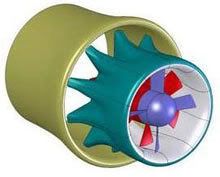





|
|
|
|
December 23, 2008
More Power From Less Wind
 FloDesign Wind Turbine, a spin-off from the aerospace company FloDesign based in Wilbraham, MA, has developed a wind turbine that could generate electricity at half the cost of conventional turbines. The company recently raised $6 million in its first round of venture financing and has announced partnerships with wind-farm developers.One of the questions that will have to be answered is does the turbine wind up sounding like a jet engine? If so it will limit the places it can be deployed. There are other problems as well. Like how will the rig stand up to 100 mph winds? Still it is a promising development. H/T Helius at Talk Polywell. Cross Posted at Power and Control posted by Simon on 12.23.08 at 05:45 AM
Comments
Actually, the benefits of this kind of design have been known almost since the invention of propellors in the 19th century. The newer American subs use ducted fans for propulsion. The basic problem of wind intermittancy, however, is not solved. Every kw of wind power requires a kw of backup coal/nuclear/oil/gas/hydro, and the intermittancy poses severe problems to the stability of the transmission grid. Sorry, I know you're a fan (no pun intended), but you are wrong about wind power. Bob Sykes · December 23, 2008 08:36 AM Bob, Wind will extend our supplies of natural gas. It has its place. In fact wind is a hedge against rising natural gas prices. And the intermittancy declines as lower speed winds become useful for electrical generation In any case I'd like to see more work go into storage. A very neglected part of the equation. Still wind is at 2% of the electrical supplies and can go to 10% without imperiling grid stability. And yes - wind requires backup. Natural gas turbines are the obvious choice due to their lower capital costs. The question is: what mix of wind and natural gas provides the lowest cost of electricity? One thing to consider is that wind output is greatest in winter when the preferential use for natural gas is heating. Seems like a good balance to me. M. Simon · December 23, 2008 08:57 AM I think the question missed in your comparison, M, is about nuclear. At what point does nuclear become cheaper per MWh than wind? Is the cost to build, say, 100 standardized design reactors at 1000 MW more or less than the comparable wind farms? And that's assuming grid and transmission capacity. The problem with the 'Pickens Plan' was always one of transmission cost. Does the cost of transmitting all that energy from tornado alley exceed the cost of putting reactors closer to the point of use? At the risk of being flippant, wind power is the wave of the future, and always will be. brian · December 23, 2008 10:38 AM Even if wind is ultimately not the way to go a 2 MV DC grid backbone would be a boon to national electrical energy reliability. It would allow power generation across several time zones. While demand in one area is peaking another area would be declining. And I agree with you about T. Boone - He is a crook. If he was proposing a 2 MV DC backbone I might have more respect for him. But he just wants more HV AC with all its problems. BTW wind is expected to be cheaper than coal or nuclear once turbine size goes above 8 to 12 MW peak. To get there faster subsidies for wind must decline - to zero. With 345 KV AC, power transmission is limited to about 500 mi. A 2 MV DC backbone would extend that to about 2,000 mi. M. Simon · December 23, 2008 11:14 AM This has been around, in reverse, for a long time. As My. Sykes notes, current US SSN designs use ducted props to improve propulsive efficiency. For the past few decades, US torpedoes have also used ducted propulsion systems. And Kort nozzles have been a standard feature on landing craft and other shallow draft vessels for at least a half century. It still seems to me that wind power might be most effective in small scale applications, in home use for example. I'm not sure how long it will be before it could be scaled up to provide significant power over a large area, if ever. Steve Skubinna · December 23, 2008 11:57 AM Post a comment
You may use basic HTML for formatting.
|
|
December 2008
WORLD-WIDE CALENDAR
Search the Site
E-mail
Classics To Go
Archives
December 2008
November 2008 October 2008 September 2008 August 2008 July 2008 June 2008 May 2008 April 2008 March 2008 February 2008 January 2008 December 2007 November 2007 October 2007 September 2007 August 2007 July 2007 June 2007 May 2007 April 2007 March 2007 February 2007 January 2007 December 2006 November 2006 October 2006 September 2006 August 2006 July 2006 June 2006 May 2006 April 2006 March 2006 February 2006 January 2006 December 2005 November 2005 October 2005 September 2005 August 2005 July 2005 June 2005 May 2005 April 2005 March 2005 February 2005 January 2005 December 2004 November 2004 October 2004 September 2004 August 2004 July 2004 June 2004 May 2004 April 2004 March 2004 February 2004 January 2004 December 2003 November 2003 October 2003 September 2003 August 2003 July 2003 June 2003 May 2003 May 2002 AB 1634 MBAPBSAAGOP Skepticism See more archives here Old (Blogspot) archives
Recent Entries
• An Awful New Game
• More Power From Less Wind • That Was Unexpected • Not by bread alone... • Politics In A Few Easy Lessons • The War • Going Whole Hog On Alternative Energy Will Increase CO2 Emissions • I Was Misinformed • Mr. Simon You're A Genius • The Deniers List
Links
Site Credits
|
|
It's intuitively wrong.